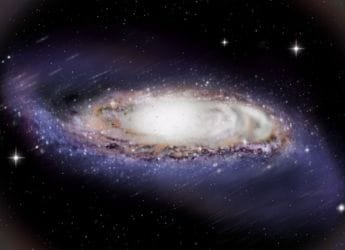- Home
- Science
- Science News
- ISRO's Mangalyaan Captures Image of Mars' Biggest Moon Phobos
ISRO's Mangalyaan Captures Image of Mars' Biggest Moon Phobos
Mangalyaan was launched on November 5, 2013, by PSLV-C25, an expandable launch system, and entered the Martian orbit on September 24, 2014, in its first attempt.

Photo Credit: Twitter/ ISRO
Phobos is believed to be made up of carbonaceous chondrites
The Indian Space Research Organisation (ISRO) on Friday shared a recent image of the mysterious moon of Mars, Phobos, as captured by the Mars Orbiter Mission also known as Mangalyaan. The image was captured on July 1 by the Mars Colour Camera.
Taking to Twitter, ISRO shared the image and wrote, "A recent image of the mysterious moon of Mars, Phobos, as captured by India's Mars Orbiter Mission."
"Mars Colour Camera (MCC) onboard Mars Orbiter Mission has imaged Phobos, the closest and biggest moon of Mars, on July 1 when MOM was about 7,200 kilometres from Mars and at 4,200 kilometres from Phobos," ISRO said.
"Phobos is largely believed to be made up of carbonaceous chondrites. The violent phase that Phobos has encountered is seen in the large section gouged out from a past collision, (Stickney crater) and bouncing ejecta. Stickney, the largest crater on Phobos along with the other craters (Shklovsky, Roche and Grildrig) are also seen in this image," ISRO further said.
The mission was launched on November 5, 2013, by PSLV-C25, an expandable launch system, and entered the Martian orbit on September 24, 2014, in its first attempt.
Why do Indians love Xiaomi TVs so much? We discussed this on Orbital, our weekly technology podcast, which you can subscribe to via Apple Podcasts, Google Podcasts, or RSS, download the episode, or just hit the play button below.
Get your daily dose of tech news, reviews, and insights, in under 80 characters on Gadgets 360 Turbo. Connect with fellow tech lovers on our Forum. Follow us on X, Facebook, WhatsApp, Threads and Google News for instant updates. Catch all the action on our YouTube channel.
Related Stories
- Samsung Galaxy Unpacked 2025
- ChatGPT
- Redmi Note 14 Pro+
- iPhone 16
- Apple Vision Pro
- Oneplus 12
- OnePlus Nord CE 3 Lite 5G
- iPhone 13
- Xiaomi 14 Pro
- Oppo Find N3
- Tecno Spark Go (2023)
- Realme V30
- Best Phones Under 25000
- Samsung Galaxy S24 Series
- Cryptocurrency
- iQoo 12
- Samsung Galaxy S24 Ultra
- Giottus
- Samsung Galaxy Z Flip 5
- Apple 'Scary Fast'
- Housefull 5
- GoPro Hero 12 Black Review
- Invincible Season 2
- JioGlass
- HD Ready TV
- Laptop Under 50000
- Smartwatch Under 10000
- Latest Mobile Phones
- Compare Phones
- Huawei Nova 15
- Huawei Nova 15 Pro
- Huawei Nova 15 Ultra
- OnePlus 15R
- Realme Narzo 90x 5G
- Realme Narzo 90 5G
- Vivo S50 Pro Mini
- Vivo S50
- Asus ProArt P16
- MacBook Pro 14-inch (M5, 2025)
- OPPO Pad Air 5
- Huawei MatePad 11.5 (2026)
- Huawei Watch 10th Anniversary Edition
- OnePlus Watch Lite
- Acerpure Nitro Z Series 100-inch QLED TV
- Samsung 43 Inch LED Ultra HD (4K) Smart TV (UA43UE81AFULXL)
- Asus ROG Ally
- Nintendo Switch Lite
- Haier 1.6 Ton 5 Star Inverter Split AC (HSU19G-MZAID5BN-INV)
- Haier 1.6 Ton 5 Star Inverter Split AC (HSU19G-MZAIM5BN-INV)

















